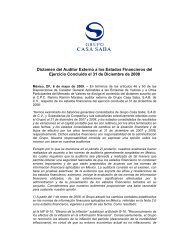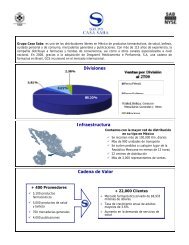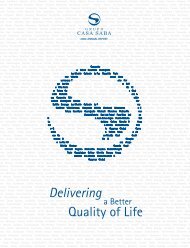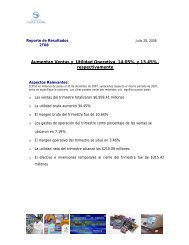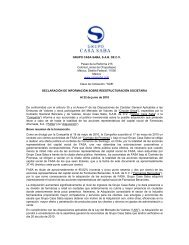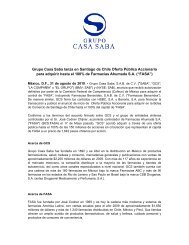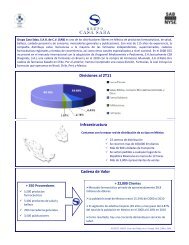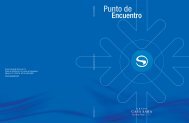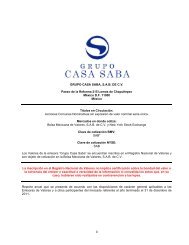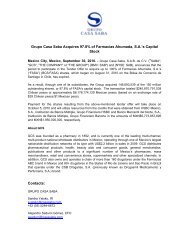- Page 1 and 2:
UNITED STATES SECURITIES AND EXCHAN
- Page 3 and 4:
TABLE OF CONTENTS PART I Item 1. Id
- Page 5 and 6:
Table of Contents We caution you th
- Page 7 and 8:
Table of Contents Year ended Decemb
- Page 9 and 10:
Table of Contents To the extent tha
- Page 11 and 12:
Table of Contents We Provide Remote
- Page 13 and 14:
Table of Contents We Are a Holding
- Page 15 and 16:
Table of Contents Today, the market
- Page 17 and 18:
Table of Contents Any future deprec
- Page 19 and 20:
Table of Contents Risk Factors Rela
- Page 21 and 22:
Table of Contents In August 2009, A
- Page 23 and 24:
Table of Contents In April of 2008,
- Page 25 and 26:
Table of Contents The Acquisition h
- Page 27 and 28:
Table of Contents On September 19,
- Page 29 and 30:
Table of Contents On September 19,
- Page 31 and 32: Table of Contents At our annual gen
- Page 33 and 34: Table of Contents We distribute the
- Page 35 and 36: Table of Contents In our stores, we
- Page 37 and 38: Table of Contents Prior to 2008, th
- Page 39 and 40: Table of Contents In 2011, we conti
- Page 41 and 42: Table of Contents To better serve s
- Page 43 and 44: Table of Contents ● Mexsana talcu
- Page 45 and 46: Table of Contents Payments and Coll
- Page 47 and 48: Table of Contents Information Techn
- Page 49 and 50: Table of Contents In addition to th
- Page 51 and 52: Table of Contents (3) In Mexico, ph
- Page 53 and 54: Table of Contents (4) To calculate
- Page 55 and 56: Table of Contents We also offer our
- Page 57 and 58: Table of Contents The devaluation o
- Page 59 and 60: Table of Contents (****) Associates
- Page 61 and 62: Table of Contents In January 2009 w
- Page 63 and 64: Table of Contents In our Retail Pha
- Page 65 and 66: Table of Contents Inflation and Int
- Page 67 and 68: Table of Contents With the acquisit
- Page 69 and 70: Table of Contents Results of Operat
- Page 71 and 72: Table of Contents Net Income. The G
- Page 73 and 74: Table of Contents On March 25, 2010
- Page 75 and 76: Table of Contents Grupo Casa Saba i
- Page 77 and 78: Table of Contents In the event that
- Page 79 and 80: Table of Contents Grupo Casa Saba h
- Page 81: Table of Contents Prior to the noti
- Page 85 and 86: Labor obligations Our labor liabili
- Page 87 and 88: Tax and legal contingencies We are
- Page 89 and 90: FRS C-4. “Inventories” (FRS C-4
- Page 91 and 92: Table of Contents As of the transit
- Page 93 and 94: Table of Contents Name and Date of
- Page 95 and 96: Table of Contents Employee Profit S
- Page 97 and 98: Table of Contents The Chairman of t
- Page 99 and 100: Table of Contents All related party
- Page 101 and 102: Table of Contents Significant Chang
- Page 103 and 104: Table of Contents The table below s
- Page 105 and 106: Table of Contents ● ● ● ● a
- Page 107 and 108: Table of Contents ● ● ● ●
- Page 109 and 110: Table of Contents Directors Under t
- Page 111 and 112: Table of Contents Forfeiture of Sha
- Page 113 and 114: Table of Contents We are organized
- Page 115 and 116: Table of Contents Ownership by non-
- Page 117 and 118: Table of Contents ● Gain on sales
- Page 119 and 120: Table of Contents We anticipate tha
- Page 121 and 122: Table of Contents As a foreign priv
- Page 123 and 124: Table of Contents Item 12. Item 12A
- Page 125 and 126: Table of Contents During the review
- Page 127 and 128: Table of Contents Since we are Mexi
- Page 129 and 130: Table of Contents PART III Item 17.
- Page 131 and 132: Table of Contents INDEX TO CONSOLID
- Page 133 and 134:
Table of Contents REPORT OF INDEPEN
- Page 135 and 136:
Table of Contents ATTESTATION REPOR
- Page 137 and 138:
Table of Contents Grupo Casa Saba,
- Page 139 and 140:
Table of Contents Grupo Casa Saba,
- Page 141 and 142:
Table of Contents NOTES TO THE CONS
- Page 143 and 144:
Table of Contents a) Through an ass
- Page 145 and 146:
Table of Contents Proforma condense
- Page 147 and 148:
Table of Contents 3. Significant ac
- Page 149 and 150:
Table of Contents The errors accoun
- Page 151 and 152:
Table of Contents Investments in as
- Page 153 and 154:
Table of Contents Effective 2011, t
- Page 155 and 156:
Table of Contents The Company recog
- Page 157 and 158:
Table of Contents The Group has cre
- Page 159 and 160:
Table of Contents In addition, the
- Page 161 and 162:
Table of Contents Foreign currency
- Page 163 and 164:
Table of Contents 8. Derivative fin
- Page 165 and 166:
Table of Contents 10. Goodwill, int
- Page 167 and 168:
Table of Contents At December 31, 2
- Page 169 and 170:
Table of Contents On January 25 and
- Page 171 and 172:
Table of Contents 13. Other payable
- Page 173 and 174:
Table of Contents 15. Foreign curre
- Page 175 and 176:
Table of Contents On December 18, 2
- Page 177 and 178:
Table of Contents c) Tax loss carry
- Page 179 and 180:
Table of Contents All significant t
- Page 181 and 182:
Table of Contents On December 7, 20
- Page 183 and 184:
Table of Contents ● ● For real
- Page 185 and 186:
Table of Contents 22. Differences b
- Page 187 and 188:
Table of Contents ii) For Mexican F
- Page 189 and 190:
Table of Contents At December 31, 2
- Page 191 and 192:
Table of Contents 23. Reconciliatio
- Page 193 and 194:
Table of Contents 24. Supplementary
- Page 195 and 196:
Table of Contents g) Quantitative a
- Page 197 and 198:
Table of Contents ● In October 20
- Page 199 and 200:
Table of Contents Page Representati
- Page 201 and 202:
CREDIT AGREEMENT (THIS “AGREEMENT
- Page 203 and 204:
(k) To the best of its knowledge, F
- Page 205 and 206:
(aa) Any and all funds used by it t
- Page 207 and 208:
“Authorized Officer” shall mean
- Page 209 and 210:
“Drawdown” shall mean each draw
- Page 211 and 212:
“Interest Payment Date” has the
- Page 213 and 214:
“Share Pledge Agreement” shall
- Page 215 and 216:
(g) The Lenders shall credit the am
- Page 217 and 218:
(e) If the Borrower defaults with a
- Page 219 and 220:
(iii) concurrently with the deliver
- Page 221 and 222:
(j) Maintenance of Property. The Bo
- Page 223 and 224:
(ii) To the extent permitted by the
- Page 225 and 226:
(ii) date thereof; Liens imposed by
- Page 227 and 228:
ARTICLE THIRTEEN. Conditions Preced
- Page 229 and 230:
(xxii) neither the execution of the
- Page 231 and 232:
(i) Insolvency. (i) If the Borrower
- Page 233 and 234:
(b) If as a result of the amendment
- Page 235 and 236:
(B) The Chilean Collateral Agent. (
- Page 237 and 238:
(iii) Neither the Chilean Collatera
- Page 239 and 240:
(h) Effective Term. Unless revoked
- Page 241 and 242:
(c) effective. Absent written notic
- Page 243 and 244:
This Credit Agreement is executed i
- Page 245 and 246:
The Chilean Collateral Agent: HSBC
- Page 247 and 248:
(c) If the Central Bank of Mexico s
- Page 249 and 250:
Joint and Several Obligations. (a)
- Page 251 and 252:
(k) Material Adverse Effect. If the
- Page 253 and 254:
Exhibit 4.3 SUMMARY OF THE IRREVOCA
- Page 255 and 256:
(6) defend, at its own cost and exp
- Page 257 and 258:
(5) the balance remaining after the
- Page 259 and 260:
In addition, articles Three, Four a
- Page 261 and 262:
(j) deliver, within five (5) days f
- Page 263 and 264:
Governing Law and Jurisdiction. Thi
- Page 265 and 266:
Servicios Corporativos Doctorgen, S
- Page 267 and 268:
Exhibit 12.2 CERTIFICATION I, Juan



